IN INDONESIA, a series of bombings raised concerns that previously suppressed militant networks in the world’s most populous Muslim-majority nation may have been reinvigorated by the return of some of the estimated +1000 Indonesians who went to fight with the Islamic State group in Syria. Security experts have warned for several years that when those fighters return to SE Asia, they could pose a significant threat not only to Indonesia but to the entire region.
On the island of Sumatra, four suspected Islamists were shot dead following an attack, using machetes and reportedly “samurai swords”, against the Police headquarters in Pekanbaru, Riau. One police officer was killed, and three were injured, in the attack at the police station, while several journalists, who were at the police station for an unrelated press conference, were injured. A fifth suspected terrorist was arrested, while police stated that a sixth person was on the run after the attack. The attack came as police conduct a massive crackdown on militants in Indonesia, some of whom have now adopted the tactic of using their own children as suicide bombers.

The attack in Pekanbaru came after 18 people were killed, and another 40 were wounded, just days earlier, when IS-aligned terrorists attacked three different churches in Surabaya. The churches attacked were the Santa Maria Roman Catholic Church, the Christian Church of Diponegoro and the Pantekosta Church.
The dead included the 6 family members who executed the attacks. The family of attackers included the two parents, their two daughters aged 9 and 12, and their two sons aged 16 and 18, who attacked the three separate locations, with the bombings happening within minutes of each other. The father detonated a car bomb, the sons used a motorcycle for their attack, and the mother and her two daughters wore hidden explosives as they walked into the third targeted church.
A matter of hours after the church attacks, a further 3 people belonging to another family unit were killed in an accidental explosion at an apartment in Sidoarjo, not far from Surabaya, by an explosive device they were allegedly readying for another attack in Surabaya.
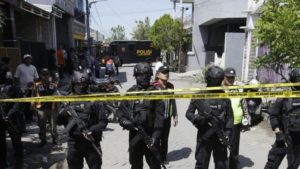
Further attacks took place one day after the attacks against the churches in Surabaya, when another IS-aligned family riding two motorbikes detonated explosive devices at a security control point at Surabaya Police headquarters, killing 4 of the family members and injuring an eight-year-old girl, who was a passenger on one of the bikes. 6 locals and 4 security officers were wounded in the attack.
Indonesian police chief General Tito Karnavian stated that the attacks appeared to be revenge for the continued detention and trial of an Indonesian terrorist leader, Aman Abdurrahman, who is currently before the courts for inspiring the attack on a Starbucks café in Jakarta in January 2016. The attacks are the first time in Indonesia that young children have been used as suicide bombers in what is rightly considered a worrying new trend.
Police have said that the attackers were members and supporters of Indonesian terror group, Jemaah Ansharut Daulah (JAD), which was formed in 2015 and which is reportedly comprised of 24 Indonesian extremist groups, all of which have pledged allegiance to the IS leader Abu Bakr al-Baghdadi. The Indonesia Police Chief announced that the father of the family that carried out the first church bombings was the head of the Surabaya cell of JAD.
General Karnavian made the claim that the orders for the bombings came from Islamic State central and that pipe bombs were used, made from triacetone triperoxide (TATP), a high explosive used extensively in Iraq and Syria, and as expected, IS quickly claimed responsibility for the church bombings in a statement released shortly after the attacks. The IS statement claiming responsibility for the attacks made no mention of families including young children taking part and claimed that there were only three attackers.
The Surabaya attacks came just days after a deadly 36-hour standoff in a high security prison housing accused terrorist inmates in Jakarta, controlled by Brigade Mobil (Brimob), a paramilitary unit of the Indonesia Police, which saw the killing of 6 Brimob officers, along with several detainees, for which IS also claimed responsibility.
Indonesian President Joko Widodo said the series of suicide attacks in Surabaya was the “act of cowards” and pledged to push through a new anti-terrorism bill to combat networks of Islamist militants in the country. He said he would issue a regulation in lieu of a law next month to force through a new anti-terrorism bill if Parliament failed to pass it, while Indonesia’s Coordinating Minister for Political, Legal and Security Affairs Wiranto said that police, supported by the military (TNI) would step up security across the country.
In support of the Indonesian President, Australian Prime Minister Malcolm Turnbull described the attacks as shocking and cowardly, a threat to “civilized ways of life” and a threat to national harmony, while “debasing and defaming Islam.”
The use of innocent children and naïve adolescents in the attacks has been particularly horrifying to Indonesians.
Indonesia’s deadliest terrorist attack occurred in 2002, when Islamist inspired militants detonated bombs on the popular tourist island of Bali, killing 202 people in one night, mostly foreigners that included 88 Australians. Jemaah Islamiyah (JI), the al-Qaeda affiliated network responsible for the Bali attacks, was then damaged by a sustained crackdown on militants by Indonesia’s counterterrorism police, supported by intelligence assistance from U.S. and Australian defence and security authorities, leading to the deaths of many of its leaders and the detention of hundreds of militants.
BACKGROUND
JAD is a terrorist group based in Indonesia that was formed in 2015 and is composed of around 24 extremist groups that pledged allegiance to IS leader Abu Bakr al-Baghdadi. JAD consists of several factions such as the splinter of the Jemaah Ansharut Tauhid (JAT) outside the leadership of Abu Bakar Bashir, the East Indonesia Mujahidin (MIT) group led by Santoso, and the Al Mujahirun group which is a splinter of the Hizb ut-Tahrir (HUT) group.
In January 2016, four people were killed and 25 wounded in an attack by a suicide bomber and gunmen in central Jakarta. That attack was attributed to JAD militants financially supported by an Indonesian IS militant, Barumshah Mennor Usman, based at that time in Syria.
On January 10, 2017 the US Department of State designated JAD as a Specially Designated Global Terrorist (SDGT) Group under Executive Order 13224, which imposes sanctions on “foreign persons determined to have committed, or who pose a serious risk of committing, acts of terrorism that threaten the security of U.S. nationals or the national security, foreign policy, or economy of the United States”. The consequences of this designation include a prohibition against U.S. persons from generally engaging in transactions with JAD, and the freezing of all property and interests in property of JAD that now or in the future are in the United States or under the possession or control of U.S. persons.
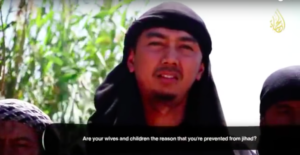 Usman, whose IS alias was Abu Ibrahim al-Indonesi, was himself classified in 2017 by the United States as an SDGT for acting for or on behalf of IS. He was an IS official who commanded IS fighters, facilitated funding for IS operations in Indonesia, recruited for IS, and coordinated travel and communications for IS members. Usman pledged allegiance to IS in 2014 and was involved in sending Indonesians to Syria. In February 2014, Usman claimed he was part of IS when he appeared at an event in support of IS at a mosque in Indonesia, declaring his aim to establish a South East Asian caliphate.
Usman, whose IS alias was Abu Ibrahim al-Indonesi, was himself classified in 2017 by the United States as an SDGT for acting for or on behalf of IS. He was an IS official who commanded IS fighters, facilitated funding for IS operations in Indonesia, recruited for IS, and coordinated travel and communications for IS members. Usman pledged allegiance to IS in 2014 and was involved in sending Indonesians to Syria. In February 2014, Usman claimed he was part of IS when he appeared at an event in support of IS at a mosque in Indonesia, declaring his aim to establish a South East Asian caliphate.

In September 2014, Usman was identified as the leader of IS’s Archipelago Group, also known as Katibah Nusantara, comprised of Indonesian and Malaysian militants, which was fighting under the IS banner in Syria. He starred in a video titled “Join the Ranks,” in which he called on supporters in Indonesia to pledge allegiance to “Emir ul-Mu’minin (Emir of the Faithful), Abu Bakr al-Baghdadi,” saying that he and his comrades had seen “with our own eyes that the Islamic State implements the Sharia of Allah in the entire land.” In addition to portraying Baghdadi’s caliphate as a jihadist paradise, Usman also declared that Islamic State was fighting Shiites and Bashar al-Assad’s regime, and another video, produced in 2015, displayed Usman with Indonesian and Malaysian children training with weapons.
By March 2016, Usman had transferred an estimated +$100,000 to the leader of a group of terrorists in Indonesia identified as the “Bekasi cell.” IS in Syria had ordered that the money be used to carry out attacks in Indonesia, attacks which reportedly included further attacks in Bali, as well as at an international school and at an airport in Jakarta.

In 2016, Indonesian police detected an underground movement seeking to recruit additional IS sympathisers to fight in Syria under the Katibah Nusantara banner
In April 2016, Usman financially assisted Wiji Joko Santoso, the leader of Indonesian terrorist group the East Indonesia Mujahidin (Mujahidin Indonesia Timur MIT), by transferring funds directly to an MIT-affiliated bank account, and indirectly to The Philippines for the purchase of weapons for the group.
Usman had reportedly departed Indonesia for Syria at the end of March 2014. He had previously been a member of Jemaah Islamiyah (JI). He was reported as killed by Western anti-IS Coalition air strikes near Palmyra Syria, in 2017.
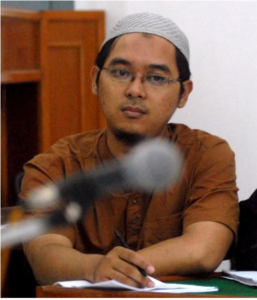 On Mar. 30, 2017, the US Government also designated Bahrun Naim, a senior Islamic State figure from Indonesia, as a terrorist. It was another in a series of US government designations targeting the self-declared caliphate’s network in Southeast Asia. Naim absconded from his home in Indonesia and made his way to the IS caliphate’s stronghold in northern Syria in late 2014, only months after Abu Bakr al-Baghdadi’s followers declared him “Caliph Ibrahim.” Naim had spent a short stint in prison in 2010 in Indonesia after being convicted on illegal weapons charges. After his release, he developed several suspicious relationships with extremists in his home city of Solo on the island of Java. Naim was also once a member of Hizb ut-Tahrir (HUT), which also seeks to resurrect an Islamic caliphate, but was considered a “small fish” in Indonesian jihadi circles before his departure for Syria.
On Mar. 30, 2017, the US Government also designated Bahrun Naim, a senior Islamic State figure from Indonesia, as a terrorist. It was another in a series of US government designations targeting the self-declared caliphate’s network in Southeast Asia. Naim absconded from his home in Indonesia and made his way to the IS caliphate’s stronghold in northern Syria in late 2014, only months after Abu Bakr al-Baghdadi’s followers declared him “Caliph Ibrahim.” Naim had spent a short stint in prison in 2010 in Indonesia after being convicted on illegal weapons charges. After his release, he developed several suspicious relationships with extremists in his home city of Solo on the island of Java. Naim was also once a member of Hizb ut-Tahrir (HUT), which also seeks to resurrect an Islamic caliphate, but was considered a “small fish” in Indonesian jihadi circles before his departure for Syria.
However, today, Indonesian authorities and allied governments throughout Southeast Asia are hunting Naim’s recruits, attempting to stop potentially dozens of men and women who have reportedly returned to Indonesia from killing in the name of the caliphate. Naim provides aspiring terrorists in Indonesia with bomb-making advice and helps them select targets to attack, though to date without notable success.
In its designation, the US Government noted that Naim had reportedly organised and funded the Jan 2016 attack in central Jakarta in which 4 people were killed and 23 more injured. The damage could have been far worse, as another team of terrorists from the Islamic State’s local branch unsuccessfully coordinated additional suicide bombings and shootings in the heart of the civilian shopping area.
Naim has reportedly assembled teams of jihadists throughout Indonesia and has augmented this network through his prolific use of social media, using encrypted messaging apps such as Telegram, creating challenges for Indonesian counterterrorism officers. The Jakarta attack is a case in point. While Naim’s digital hand was detected in the planning of the operation, other jihadist figures inside Indonesia were also instrumental in the planning if not the execution of the attack.
Counter terror authorities in Indonesia and internationally reported that Naim had orchestrated at least 15 foiled plots, with around 150 terrorism related arrests in Indonesia, during 2016 alone. In Aug 2016, Indonesian police raided one Naim’s cells on Batam island, from where his jihadists reportedly intended to fire rockets at Singapore’s Marina Bay, located 15 kilometres away, across the waterway. Marina Bay is an especially affluent area, with high-end shopping, a busy casino and other attractions that are frequented by both Singaporeans and international travellers. According to Indonesia Police Chief Karnavian, members of the Batam cell were in direct contact with Bahrun Naim in Syria and he had ordered them to attack Singapore and Batam.
Members of the Batam group, as with many of Naim’s other accomplices, were neutralised quickly, but of concern is Naim’s reported expertise in crafting sophisticated explosive devices, knowledge of which he has been transferring to his sympathisers and followers inside Indonesia, and potentially regionally. He is also luring women into his operations, describing them as terror “brides.”
In November 2016, Indonesian authorities discovered a terror cell that reportedly had ambitious plans to strike several targets at once, including the Indonesian Parliament, during the end of year holiday season. It was reported that the IS loyalists had obtained military-grade explosive material such as TNT and RDX in such large quantities that it could have caused substantially more damage than was caused by the 2002 Bali bombings. And in December 2016, Indonesia’s elite counterterrorism force, Detachment 88 (Densus 88), detected a cell of jihadists who were planning to bomb Jakarta’s Presidential Palace. Densus 88 reported that the recovered explosive device was more powerful than military-grade TNT, with the possibility of destroying everything within a radius of 300 metres.
IS jihadis reportedly intended to have a woman, Dian Yulia Novi, deliver the explosive device to the Palace. Novi’s husband, Nur Solihun, was also involved in the plot, and authorities later discovered the “martyrdom” letter she wrote to her parents. Naim recruited her husband, who was already married to another woman, and instructed him to find a bride capable of carrying out an operation. After her arrest, Novi subsequently confessed that Naim had ordered her to strike the Presidential Palace during the changing of the guard ceremony.
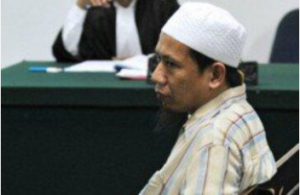 Another person of concern to Indonesian security authorities is a radical cleric, Oman Rochman (also known as Aman Abdurrahman) who, though he has been imprisoned in Indonesia since 2010, directed IS’s operations inside Indonesia for months following the declaration in 2014, by al-Baghdadi, of the Caliphate in Syria and Iraq.
Another person of concern to Indonesian security authorities is a radical cleric, Oman Rochman (also known as Aman Abdurrahman) who, though he has been imprisoned in Indonesia since 2010, directed IS’s operations inside Indonesia for months following the declaration in 2014, by al-Baghdadi, of the Caliphate in Syria and Iraq.
Rochman was originally convicted on terrorism-related charges stemming from his support for a camp run by Jemaah Islamiyah, an al-Qaeda-affiliated group, which is violently opposed to IS. However, as al-Baghdadi’s attraction to potential jihadis increased from 2014, the Indonesian jihadist network splintered, with some supporting AQ while others, including Rochman, chose the more radical IS, leading to Rochman’s designation as a terrorist by the US Government, describing him as the “de facto leader for all IS supporters in Indonesia.” From prison in Indonesia, Rochman continued to play a prominent role in recruiting Indonesians for IS operations abroad, personally blessing the travels of some new recruits. He has acted as the primary disseminator of IS propaganda throughout Indonesia, and in early 2016 he issued a fatwa (decree) encouraging Indonesian militants to join al-Baghdadi’s caliphate.
Rochman worked to build Islamic State’s organisational capacity inside Indonesia. Jemmah Ansharut Tauhid (JAT) was one of the many Indonesian extremist groups affected by the rise of Abu Bakr al-Baghdadi’s enterprise and its global competition with al-Qaeda. Rochman provided a veneer of religious authority for the targeting of innocent Muslim civilians. In 2017, Indonesian authorities finally understood the level of his support and influence and transferred him to a high security facility, to limit his contact with outsiders. Regardless of the limitations on Rochman’s contact with his supporters, the threat posed by IS’s local network remains virulent.
After the IS declaration of a Caliphate in 2014, many Indonesian jihadists rushed to declare their allegiance, leading to confusion over which group would represent al-Baghdadi’s cause. This led to the creation of JAD in 2015, as an umbrella organisation for the two dozen or so Indonesian extremist groups that had pledged allegiance to IS leader Abu Bakr al-Baghdadi. Rochman’s hand guided the consolidation process.
MALAYSIA
Authorities are confronting a similar, albeit less numerous, stream of threats in nearby Malaysia. A Malaysian jihadist named Muhammad Wanndy bin Mohamed Jedi, better known as “Wanndy” (and in Syria as Abu Sayyaf al-Malizi) had, from Syria to where he had traveled in January 2015, claimed responsibility on behalf of IS for the June 2016 grenade attack on a nightclub, the Movida bar, in Puchong, a town outside Kuala Lumpur, Malaysia in which eight people were wounded (the attackers were later captured and sentenced to 25 years imprisonment).
 The nightclub assault was the first successful “operation” conducted by al-Baghdadi’s IS followers in Malaysia, but it was not the only remote-control plot Wanndy had been involved in. Earlier, in March 2016, Malaysian authorities had arrested a cell of 15 Malaysia-based militants who were subordinate to Wanndy and who supported IS operations in Syria.
The nightclub assault was the first successful “operation” conducted by al-Baghdadi’s IS followers in Malaysia, but it was not the only remote-control plot Wanndy had been involved in. Earlier, in March 2016, Malaysian authorities had arrested a cell of 15 Malaysia-based militants who were subordinate to Wanndy and who supported IS operations in Syria.
 Wanndy was reportedly killed by a Coalition drone attack (his vehicle, below, pictured after the attack) in Raqqa, Syria in late April 2017 (his death was confirmed online by his wife, and later confirmed by Malaysia’s Inspector-General of Police, Khalid Abu Bakar). Doubts persist about his death, with claims that he staged his own death to escape drone attacks and for having stolen IS funds.
Wanndy was reportedly killed by a Coalition drone attack (his vehicle, below, pictured after the attack) in Raqqa, Syria in late April 2017 (his death was confirmed online by his wife, and later confirmed by Malaysia’s Inspector-General of Police, Khalid Abu Bakar). Doubts persist about his death, with claims that he staged his own death to escape drone attacks and for having stolen IS funds.
At any rate, dead or in hiding, his removal from the jihadi scene has complemented Malaysian Special Branch’s success in disrupting multiple IS-inspired plots in Malaysia, leading to the arrests of over 250 Malaysian IS members and sympathisers over the past 5 years
Regional counterterrorism officials fear that since IS has lost substantial territory in Iraq and Syria, many foreign fighters will return to Malaysia and Indonesia. Though effectively neutralised themselves, Naim (hiding somewhere in Syria or Iraq?), Usman (killed), Rochman (jailed) and Wanndy (killed?) had recruited hundreds of fighters for the Islamic State’s Malay-speaking unit, the KN. Those who have not died as the caliphate lost control over its territory are expected to reorganize in SE Asia, where IS’s international network already has a significant footprint.
Genera; Tito Karnavian, the Indonesian police chief, in calling for regional cooperation to counter the emerging threats, believes that Bahrun Naim seeks “to unite all supporting elements in Southeast Asia, including Indonesia, Malaysia, and The Philippines.” However, the reality is that jihadis such as Naim will not live to see a caliphate rise in Southeast Asia. Although he has numerous potential co-conspirators waiting to assist his cause, and though there have been the recent high-profile attacks in Indonesia (and earlier in The Philippines, at Marawi town where 700 people, including 120 Filipino soldiers, were killed in the 5-months long Islamist uprising, in which an estimated 20 Indonesian jihadists participated), SE Asian jihadists are not currently overwhelming the region’s security and intelligence forces,
MYANMAR: This month, ethnic insurgents killed 19 people, including 4 members of the security forces, in an attack at Muse, a major border crossing to China.
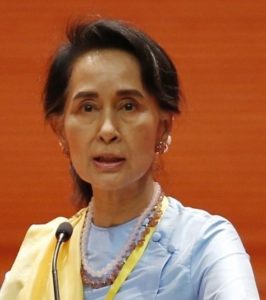
 The conflict in the north of Myanmar has escalated over the past month, and the latest attack marks a further setback for civilian leader Aung San Suu Kyi’s stated priority of achieving peace amid the stuttering transition from full military rule. This comes on top of the international condemnation heaped on Myanmar by the international community, following the forced exodus of up to 700,000 Rohingya refugees from Myanmar into squalid camps in neighbouring Bangladesh.
The conflict in the north of Myanmar has escalated over the past month, and the latest attack marks a further setback for civilian leader Aung San Suu Kyi’s stated priority of achieving peace amid the stuttering transition from full military rule. This comes on top of the international condemnation heaped on Myanmar by the international community, following the forced exodus of up to 700,000 Rohingya refugees from Myanmar into squalid camps in neighbouring Bangladesh.
Even international icon for peace Aung San Suu Kyi has not been immune to criticism, losing much of the international support (fickle as it is) that she built up over the decades of oppression and detention she was forced to endure in Myanmar
A spokesman for the Ta’ang National Liberation Army (TNLA), made up of fighters from the Ta’ang or Palaung ethnic group, said the group had attacked a casino run by local militiamen, and a Myanmar army post on the outskirts of Muse, several hundred meters from the river that divides Myanmar’s northern Shan state and China’s Yunnan province.
Myanmar’s military frequently clashes with armed ethnic groups (Kachin, Karen, Wa, Shan) who say they are fighting for greater autonomy for ethnic minorities in the country.
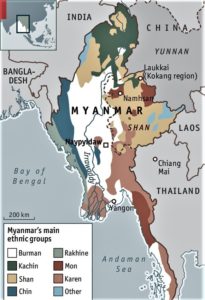 A Myanmar Government spokesman claimed that around 100 insurgents attacked using small arms and light “artillery” (in all likelihood mortars), before being repelled by armed police and members of a government-backed militia referred to as paramilitaries. The spokesman announced that 15 civilians, including 2 women, had been killed by the attackers, with another 20 injured, while a police officer and 3 local militiamen were also killed in the clash.
A Myanmar Government spokesman claimed that around 100 insurgents attacked using small arms and light “artillery” (in all likelihood mortars), before being repelled by armed police and members of a government-backed militia referred to as paramilitaries. The spokesman announced that 15 civilians, including 2 women, had been killed by the attackers, with another 20 injured, while a police officer and 3 local militiamen were also killed in the clash.
According to a spokesman for the TNLA, the local militias are accused of protecting the casinos, which are considered a gateway for the distribution of drugs, creating a variety of social problem. The assault was also, according to the TNLA spokesman, in retaliation for recent attacks on TNLA outposts and for a military push in Kachin state to the north, where a recent and ongoing offensive against the Kachin Independence Army, a TNLA ally, has reportedly displaced more than 6,000 people in the past month alone.
 The TNLA and other insurgent groups are fighting with authorities in Myanmar for greater autonomy for ethnic minorities in the area, and the conflict has quietly escalated over the past month, as international focus remains on the Rohingya crisis in the west of the country
The TNLA and other insurgent groups are fighting with authorities in Myanmar for greater autonomy for ethnic minorities in the area, and the conflict has quietly escalated over the past month, as international focus remains on the Rohingya crisis in the west of the country
According to a representative for the KIA, the Burmese military deployed 2,000 infantry troops, fighter aircraft and helicopters against the TNLA/KIA alliance, leading to the worst clashes since the early 1960s, when the ethnic rebellion commenced in earnest.
When Myanmar’s de facto leader, Aung San Suu Kyi, took office in 2016, she declared to the world that making peace with the country’s ethnic minorities was her main priority, but progress has been slow as several ethnic armed groups continue to demand autonomy and power in the Buddhist-majority country, where Burmese Buddhists occupy most political and military positions.
BACKGROUND
Myanmar’s Armed Forces, the Tatmadaw, and the Kachin Independence Army are fighting for control of lucrative natural resources in Kachin State.
The Army has been launching air strikes in the gold, jade and amber mining region inside Kachin state in recent months. The area is controlled by the Kachin Independence Organization (KIO) and its armed group, the 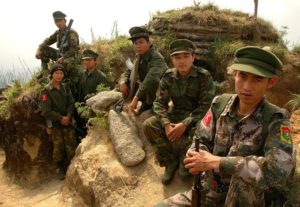 Kachin Independence Army (KIA). The military’s strategic aim is to clear out illegal mines in the area that provide a lucrative source of income for the KIO. But the reality is that underneath this military operation is a war over resources between the Burmese Army and the KIO in Kachin state, where control of not only gold and amber but also jade, copper, and ruby mines in the area is economically important for both the Army and the KIO.
Kachin Independence Army (KIA). The military’s strategic aim is to clear out illegal mines in the area that provide a lucrative source of income for the KIO. But the reality is that underneath this military operation is a war over resources between the Burmese Army and the KIO in Kachin state, where control of not only gold and amber but also jade, copper, and ruby mines in the area is economically important for both the Army and the KIO.
Kachin state has several ethnic armed groups that possess substantial business assets, particularly in mining of resources, but the main group is KIO. As part of the 1994 ceasefire, the leaders of these groups were seduced into joining new patronage networks that allowed insurgent groups to control some territory and natural resources, in exchange for their loyalty to the central government in Naypyidaw. However, over time, the ethnic armed groups began to see the Burmese Army competing with them for control of all natural resources. In time, the Army’s presence in the area increased, and the State began to divert foreign investments through official State channels, signing deals with foreign investors, banning trade through certain border towns, and redirecting everything through Yangon.
The Kachin
The principal beneficiaries of mining of resources in the regions have been a narrow group of ethnic minority elites, regional army commanders, and foreign investors. Competition for control of resources takes place particularly between ethnic minority elites and regional army commanders, while the local community continues to suffer from poverty, living a hand-to-mouth subsistence existence.
In the Kachin conflict, the key players are the Army and the KIO. Mining has provided incentives and financing for both these groups to continue fighting. In fact, many of the largest licensed mining companies are controlled by the families of politically influential retired generals, so any peace deal would mean that the incomes of these companies would be affected, while also reducing the incomes of some of the KIO leaders.
Resolving Myanmar’s protracted civil wars with its ethnic minorities, which have raged since independence in 1948, is the country’s primary challenge in the 21st century. But reconciling the demands of a dizzying range of ethnic armies with the centralising vision of the powerful Myanmar armed forces has proven challenging.
In Kachin state, the KIA rebels say they are anticipating a winter offensive by the Burmese Army, and they complain loudly and bitterly about the double standards shown by the international community toward their own ethnic conflict (which they insist affects their very survival) and the Rohingya issue in Rakhine state. But the situation in Shan state is perhaps more critical, since there are many more armed factions there, including the KIA, and events are conspiring to undermine the semblance of control exercised by the Burmese Army in the region.
Army control in Shan state (particularly the north) operates through a garrison state concept, where control outside of the main towns and cities rests heavily on a combination of controlling the area’s few major highways, supported by divide-and-rule tactics, plus a patchwork of armed local militias (PMF – people’s militia forces) in the rural hinterlands’ few township centers. These PMFs are considered by many in the area to be collaborators with the Burmese Army, and they are often perceived by the local population as the untrustworthy face of an authoritarian Myanmar state.
With a decades-long relationship with China, the Burmese Army appears to hope that China can be persuaded to exert its influence over its ethnic allies, to rein in their resistance to central Government, under the threat of expanding low scale military operations. The danger is that the rebel alliance will take the opportunity to respond by launching their own coordinated counteroffensive to repel the Army, as has happened previously, as recently as November 2016.
Despite early optimism, the formation of a new civilian-led government in Myanmar under the leadership of “Special Counsellor” Aung San Suu Kyi has not led to permanent improvements in the general political situation, in part because the junta that controlled Myanmar beforehand imposed a new Constitution, with the aim of limiting and restraining the independence of any future civilian Government. This is essentially what has happened since 2015, and the Burmese Army retains significant political power, independent of civilian oversight, while also retaining control of the key security ministries. With a protected 25% of seats in Myanmar’s parliament, it also has a veto over Constitutional changes that might challenge this.
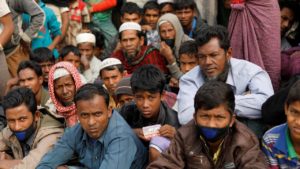 Adding to the threat internally, there are as-yet-unconfirmed rumours that IS aligned jihadists returning from Iraq and Syria have infiltrated the refugee camps in Bangladesh and are exploiting the anger and grief of the Rohingyas, with the intention of building a cadre of trained and motivated jihadists keen to return to Myanmar to attack infrastructure and the Buddhist Burmese population, who they see as their oppressors.
Adding to the threat internally, there are as-yet-unconfirmed rumours that IS aligned jihadists returning from Iraq and Syria have infiltrated the refugee camps in Bangladesh and are exploiting the anger and grief of the Rohingyas, with the intention of building a cadre of trained and motivated jihadists keen to return to Myanmar to attack infrastructure and the Buddhist Burmese population, who they see as their oppressors.
OAM operates extensively in the SE Asia and Indochina Peninsula regions, and has a strong network of highly connected associates throughout Thailand, Myanmar and Cambodia


Leave a Reply